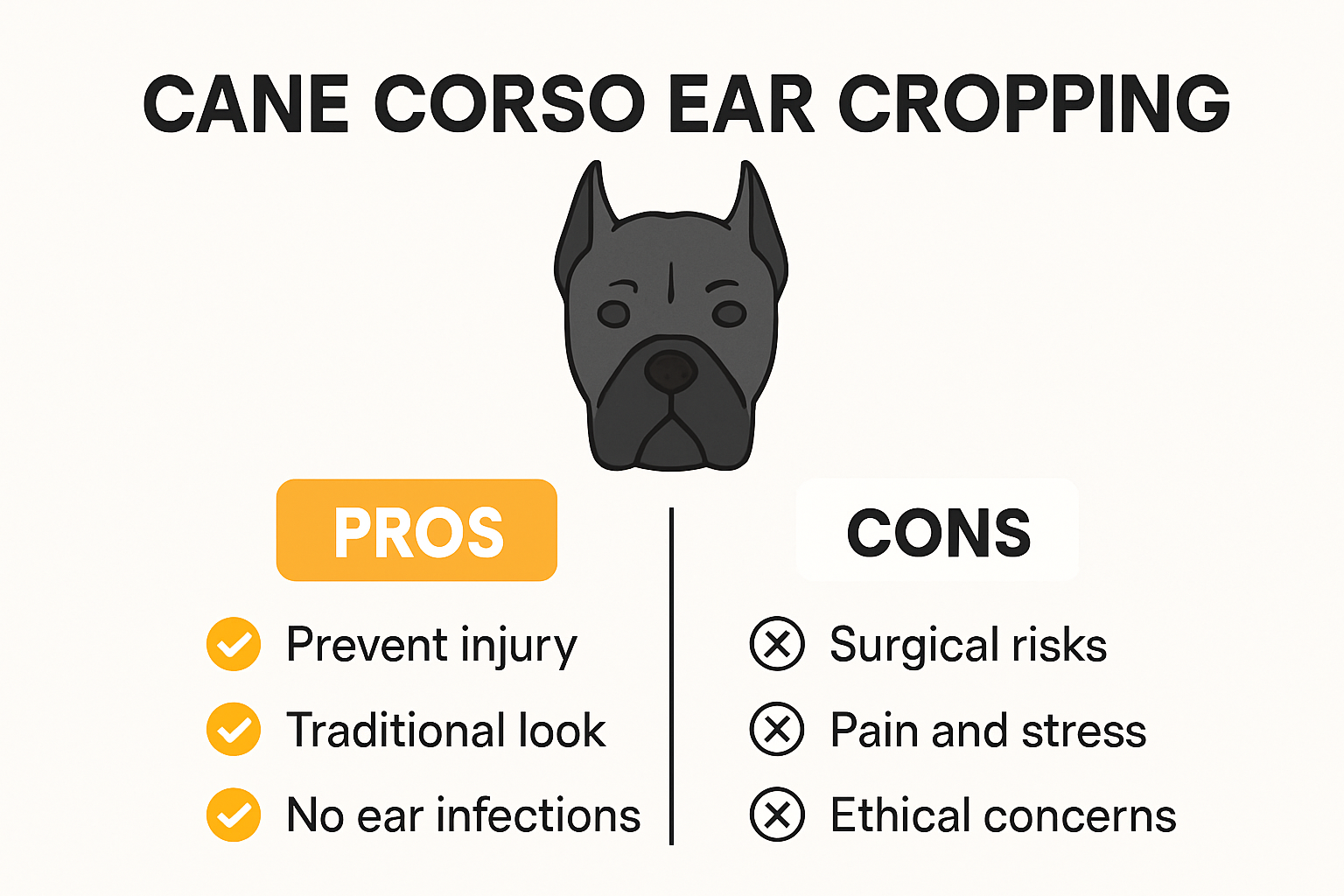Cane Corso ear cropping is surrounded by controversy, strong opinions, and changing laws. Here is what might surprise you. Over 20 countries now ban ear cropping due to animal welfare concerns, yet nearly half of Cane Corsos in the U.S. still undergo the procedure. Most people assume this surgery is for the dog’s health or safety, but many veterinarians agree it offers no proven medical benefits. The real reason people still do it often comes down to outdated ideas about appearance and tradition, not science or necessity.
Table of Contents
- What Is Cane Corso Ear Cropping?
- Pros And Cons Of Ear Cropping
- Ear Cropping Procedure And Aftercare
- Legal And Ethical Considerations In 2025
Quick Summary
| Takeaway | Explanation |
|---|---|
| Cane Corso ear cropping is a surgical procedure with complex implications. | The procedure involves removing part of the ear flap of Cane Corso puppies to alter their appearance, traditionally for aesthetic reasons rather than medical needs. |
| Legal status varies globally, with growing opposition. | Ear cropping is banned in many countries due to animal welfare concerns, while in the U.S., it remains legal but faces increasing scrutiny and potential regulation changes. |
| Potential drawbacks significantly outweigh benefits. | The risks include pain, complications during healing, and negative social perceptions. Many veterinarians and animal welfare groups argue against the procedure, emphasizing dogs’ rights to minimal medical intervention. |
| Ethical considerations are paramount for dog owners. | Responsible ownership involves prioritizing the dog’s health and comfort over cosmetic preferences, respecting the natural ear structure as a better choice for well-being. |
| Post-operative care is critical if surgery is pursued. | Owners must prepare for extensive aftercare to ensure proper healing, including pain management and preventing infection. |
What Is Cane Corso Ear Cropping?
Cane Corso ear cropping is a surgical procedure that transforms the natural ear shape of this powerful Italian Mastiff breed. This controversial practice involves surgically removing a portion of the dog’s ear flap, typically performed on puppies between six and twelve weeks of age. The goal is to create a more erect, pointed ear appearance that some breed enthusiasts argue aligns with traditional breed standards.
The Surgical Process and Motivation
The ear cropping procedure is complex and requires precision. Veterinary surgeons carefully remove part of the ear cartilage under general anesthesia, followed by a critical healing and management phase. Learn more about Cane Corso breed characteristics to understand why this practice remains significant for some owners.
Motivations for ear cropping vary widely. Traditionally, working dogs like the Cane Corso had ears cropped to prevent potential injury during guard or hunting work. The upright ear design was thought to reduce the risk of ear tears during confrontations or while moving through dense vegetation. Today, the reasons are predominantly cosmetic, with many owners seeking a more intimidating or classic breed appearance.
Legal and Ethical Considerations
The practice of ear cropping remains highly controversial. According to research from the Royal Society for the Prevention of Cruelty to Animals, the procedure is illegal in many countries including the United Kingdom, Germany, and Norway due to significant animal welfare concerns. In the United States, however, ear cropping remains legal and continues to be practiced.
Veterinarians and animal welfare experts consistently argue that ear cropping provides no medical benefits. The procedure can cause significant pain, potential complications during healing, and may lead to permanent psychological and physical trauma for the dog. Many professional organizations, including veterinary associations, actively discourage the practice as unnecessary and potentially harmful.
For potential Cane Corso owners, the decision to crop ears should involve careful consideration. Understanding the medical, ethical, and breed-specific implications is crucial. While some breeders and show standards traditionally favored cropped ears, modern perspectives increasingly recognize and appreciate the natural ear structure of this magnificent breed. Ultimately, the choice reflects personal preference balanced against animal welfare principles and the dog’s long-term health and comfort.
Pros and Cons of Ear Cropping
Ear cropping for Cane Corsos presents a complex landscape of arguments both supporting and challenging the practice. While some breed enthusiasts maintain strong positions, the debate continues to evolve with growing awareness about animal welfare and breed standards. Learn more about Cane Corso breed characteristics to understand the broader context of this discussion.
Potential Advantages of Ear Cropping
Proponents of ear cropping argue several potential benefits for Cane Corsos. Traditionally, working dogs required ear modifications to reduce injury risks. According to research from veterinary experts, some claim that cropped ears may provide protective advantages. These potential benefits include reduced risk of ear infections, minimized chances of ear tears during physical activities, and improved hearing precision.
In working or guard dog contexts, cropped ears are believed to enhance the breed’s intimidating appearance. Some breeders and owners suggest that the upright ear configuration allows for better sound localization and potentially improved auditory perception. However, scientific evidence supporting these claims remains limited and largely anecdotal.
Significant Drawbacks and Ethical Concerns
The disadvantages of ear cropping significantly outweigh potential benefits. According to studies on animal welfare, dogs with cropped ears often experience negative social interactions. People tend to perceive these dogs as more aggressive, which can impact their ability to socialize and interact positively with humans and other animals.
Medical risks associated with the procedure are substantial. The surgical process involves general anesthesia, potential complications during healing, and significant pain for the puppy. Veterinary professionals consistently argue that ear cropping provides no genuine medical benefits. The procedure can lead to permanent psychological and physical trauma, potentially affecting the dog’s long-term health and behavioral development.
Moreover, the ethical considerations are profound. Many countries have banned or restricted ear cropping due to animal welfare concerns. The procedure is considered unnecessary cosmetic surgery that causes undue suffering. Professional veterinary organizations worldwide actively discourage the practice, emphasizing that dogs can lead healthy, functional lives with their natural ear structure.
For Cane Corso owners, the decision requires careful reflection. While historical breed standards may have favored cropped ears, modern perspectives increasingly value the dog’s natural appearance and well-being. The choice ultimately involves balancing personal aesthetic preferences with ethical considerations and the dog’s fundamental right to minimal medical intervention. Responsible ownership means prioritizing the animal’s health, comfort, and quality of life over cosmetic modifications.
Ear Cropping Procedure and Aftercare
The ear cropping procedure for Cane Corsos is a complex and delicate surgical intervention that requires extensive professional expertise and meticulous post-operative care. Explore our comprehensive guide to Cane Corso breed characteristics to better understand the context of this breed-specific practice.
Surgical Process and Timing
Ear cropping is typically performed on Cane Corso puppies between six and twelve weeks of age. According to veterinary research, this narrow age window is crucial for optimal healing and ear formation. The procedure involves general anesthesia and precise surgical removal of a portion of the ear flap. A skilled veterinary surgeon carefully trims the ear cartilage to achieve the desired upright ear shape characteristic of the breed.
The surgical technique requires exceptional precision. Veterinarians must consider multiple factors including the puppy’s age, ear structure, and desired final ear appearance. Different crop styles exist dogs, including short, medium, and show crop variations each with unique aesthetic and practical implications. The surgeon makes calculated incisions to remove specific portions of the ear while minimizing trauma and ensuring proper healing potential.
Comprehensive Aftercare Requirements
Post-surgical care is critically important and demands significant owner commitment. Veterinary experts emphasize that the healing process requires meticulous attention to prevent infection and ensure proper ear positioning. The immediate aftercare typically involves:
- Wound Management: Keeping surgical sites clean and protected
- Pain Control: Administering prescribed pain medications
- Ear Posting: Using specialized splints or supports to maintain desired ear position
- Infection Prevention: Regular veterinary check-ups and careful monitoring
The recovery period can extend several weeks, during which the puppy requires constant supervision. Owners must prevent the dog from scratching or interfering with the healing ears. Specialized medical wraps and protective collars are often necessary to support proper healing and minimize complications.
The potential risks associated with the procedure are significant. According to animal welfare research, complications can include excessive bleeding, infection, improper healing, and potential long-term psychological impact. Professional veterinarians consistently recommend thorough consultation and careful consideration before proceeding with ear cropping.
For Cane Corso owners contemplating this procedure, understanding the complete process is crucial. The decision requires balancing aesthetic preferences with potential medical risks and ethical considerations. Professional guidance from experienced veterinarians who specialize in breed-specific surgical procedures can provide invaluable insights into making an informed choice that prioritizes the puppy’s health and well-being.
Legal and Ethical Considerations in 2025
As we enter 2025, the landscape of ear cropping for Cane Corsos continues to evolve, reflecting shifting societal attitudes toward animal welfare and breed standards. Learn more about Cane Corso breed characteristics to understand the broader context of these ongoing discussions.
Global Legal Perspectives
The legal status of ear cropping varies dramatically across different regions. According to comprehensive research from animal welfare organizations, many countries have implemented strict regulations or outright bans on the practice. European nations like the United Kingdom, Germany, and Norway have long prohibited ear cropping, viewing it as an unnecessary and cruel cosmetic procedure.
In the United States, the legal landscape remains complex. While no federal law explicitly bans ear cropping, some states have begun considering more restrictive regulations. The American Veterinary Medical Association (AVMA) has taken a clear stance, opposing the procedure and encouraging its elimination from breed standards. This professional recommendation signals a significant shift in veterinary perspectives, potentially influencing future legal frameworks.
Ethical Considerations and Animal Welfare
The ethical debate surrounding ear cropping has intensified in recent years. Veterinary professionals and animal welfare experts consistently argue that the procedure provides no medical benefits and causes unnecessary pain and potential long-term psychological trauma. Key ethical concerns include:
- Unnecessary Surgical Intervention: No proven medical justification for the procedure
- Animal Suffering: Potential for pain and psychological distress
- Informed Consent: Inability of the animal to provide consent for cosmetic surgery
Breed organizations and show standards have also begun reevaluating their stance. Many are moving away from requiring cropped ears as a breed standard, recognizing the importance of animal welfare over aesthetic preferences. This shift reflects a broader societal movement toward more compassionate and scientifically informed approaches to animal care.
The implications extend beyond legal and medical considerations. Public perception has dramatically changed, with increasing numbers of dog owners and potential Cane Corso enthusiasts viewing ear cropping as an outdated and unethical practice. Social media and increased awareness of animal welfare have played significant roles in challenging traditional breed practices.
For Cane Corso owners and potential owners in 2025, the decision about ear cropping requires careful ethical reflection. The trend is clearly moving toward preserving the dog’s natural physical characteristics and prioritizing their health and well-being. Responsible ownership now means understanding and respecting the animal’s inherent right to remain free from unnecessary surgical modifications. The most ethical approach involves embracing the breed’s natural beauty and focusing on proper training, socialization, and care that truly enhance the dog’s quality of life.
Frequently Asked Questions
What is Cane Corso ear cropping?
Is ear cropping legal in the U.S.?
What are the risks associated with ear cropping?
Why do some owners choose to crop their Cane Corso's ears?
Support Your Cane Corso’s Health and Confidence—Today
Making decisions about Cane Corso ear cropping is tough. As the article explains, you want to protect your dog’s well-being but face mixed information and emotional pressure on what’s truly best for your loyal companion. It can feel overwhelming to balance breed traditions, legal concerns, and the responsibility for your dog’s comfort, especially when ethical and health issues are front and center.
Explore expert health and wellness guidance that will help you confidently navigate ear care and overall well-being for your Cane Corso.
Ready to choose the healthiest, most informed path for your dog? Join our supportive Cane Corso Mastiff community now for trusted advice, owner stories, and practical resources that put your dog’s health and happiness first. Take the next step and ensure your Cane Corso thrives with the knowledge and care they deserve.
Recommended Articles
- All You Need to Know: Cane Corso Grooming Needs Simplified
- Cane Corso Grooming Guide 2025: Keep Your Guardian Dog Healthy
- Cane Archives – Cane Corso Mastiff




